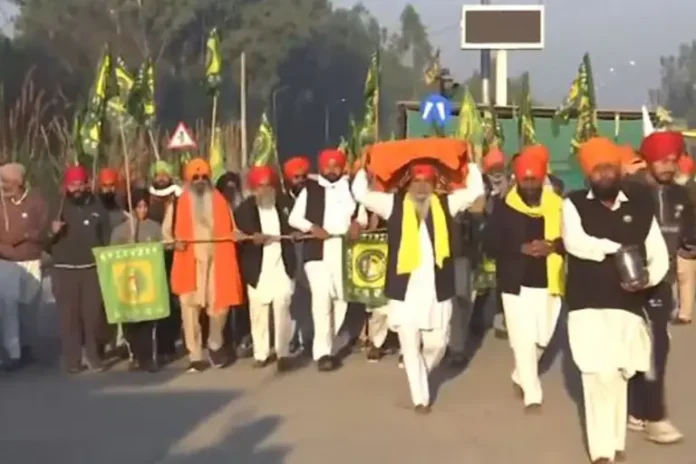In a display of determination and solidarity, hundreds of farmers have assembled at the Shambhu border, preparing for a protest march towards Delhi on December 6, 2024. This mobilization, spearheaded by organizations such as the Samyukta Kisan Morcha (Non-Political) and Kisan Mazdoor Morcha, seeks to highlight 12 pressing demands aimed at safeguarding the livelihood and dignity of India’s agrarian community.
The Farmers’ Demands: A Fight for Livelihoods
At the heart of the farmers’ agitation is the demand for a legal guarantee on Minimum Support Price (MSP), which they argue is crucial for ensuring fair compensation for their crops. Other significant demands include:
- Waivers on farm loans to alleviate debt burdens.
- Pensions for farmers and laborers to ensure post-retirement security.
- A rollback of proposed increases in electricity tariffs.
- Withdrawal of police cases filed against protesting farmers during past agitations.
- Fair compensation for crop losses caused by natural disasters.
- Enhanced subsidies for agricultural inputs, including fertilizers and seeds.
- Protection against land acquisition without adequate compensation.
- Reforms in irrigation systems and availability of water for agriculture.
- Stricter regulations on corporate exploitation in agriculture.
- Better pricing policies for dairy and allied sectors.
- Comprehensive crop insurance schemes to mitigate risks.
- Immediate payment of pending dues to farmers, especially in the sugarcane sector.
The demands reflect widespread grievances, underscoring the challenges faced by farmers across India’s agricultural heartlands.
Security Tightened: A March Under Watch
The Ambala district administration, anticipating a large-scale gathering, has implemented strict security measures at the Shambhu border. Prohibitory orders under Section 163 of the Bharatiya Nagarik Suraksha Sanhita have been enforced, restricting assemblies of five or more individuals.
Additional barricades and a heightened police presence are in place, supported by central paramilitary forces to manage the situation and ensure law and order. Authorities cite public safety concerns, but farmer leaders have criticized these measures as excessive, likening the scene to an international border.
Voices from the Ground
Farmer leader Sarwan Singh Pandher expressed frustration at the heavy security deployment. “This is not a war zone; it is a peaceful protest for our rights. If they stop us, it will be a moral victory for the farmers,” Pandher stated.
The first group of marchers, referred to as a “jatha,” consists of 101 farmers who will lead the procession towards Delhi. Protesters have been stationed at the Shambhu border since February 2024, following previous attempts to reach the national capital that were thwarted by security forces.
Historical Resonance and Symbolic Significance
The march coincides with Guru Teg Bahadur Ji’s martyrdom day, adding symbolic depth to the farmers’ cause. Protesters see this alignment as a reflection of their fight for justice and equality, drawing inspiration from the historical legacy of sacrifice and resistance.
The movement has now persisted for nearly 300 days, demonstrating the resilience of India’s farmers in their struggle for equity and recognition.
Government’s Stance: Measures to Prevent the March
The Haryana government has taken stringent steps to prevent the march from reaching Delhi. In addition to enforcing Section 163, officials have warned protesters of legal repercussions for violating prohibitory orders.
Haryana Chief Minister Manohar Lal Khattar has called for dialogue, urging farmers to engage in discussions rather than disruptive demonstrations. However, farmer groups have expressed skepticism, citing unmet promises from previous negotiations.
Public Sentiment and Reactions
The protest has garnered mixed reactions from the public. While many urban residents express frustration over potential disruptions to daily life, there is widespread sympathy for the farmers’ plight in rural areas. Social media platforms are abuzz with hashtags like #FarmersMarchToDelhi and #SupportFarmers, reflecting both solidarity and criticism.
Local communities near the Shambhu border have extended support to the protesters by providing food and shelter, showcasing grassroots-level solidarity with the farmers’ cause.
Safety and Organization
Despite the potential for confrontation, farmer groups have emphasized the peaceful nature of their protest. Volunteers have been assigned to ensure discipline during the march, and leaders have repeatedly urged participants to avoid any actions that could lead to violence.
The Road Ahead
As the clock ticks towards the march’s commencement at 1 PM, the spotlight remains on the Shambhu border. The farmers’ resolve to march towards Delhi, despite legal and logistical hurdles, underscores the depth of their grievances.
Notable Figures in the Protest
Prominent leaders from the agrarian community, including Sarwan Singh Pandher and representatives from the Kisan Mazdoor Morcha, are leading the charge. Though the protest is labeled “non-political,” its scale and implications have drawn attention from political parties and civil society organizations alike.
Broader Implications
The farmers’ march is not just a protest; it is a reflection of the systemic challenges plaguing Indian agriculture. The outcome of this march will have far-reaching implications for government policies, rural livelihoods, and the broader discourse on India’s agrarian economy.
As the march unfolds, all eyes will be on Delhi, where the farmers hope to make their voices heard. Whether their demands are met remains uncertain, but their determination to fight for their rights remains unwavering.
This protest, steeped in symbolism and driven by necessity, represents a pivotal moment in the ongoing struggle for justice and equity in Indian agriculture.



